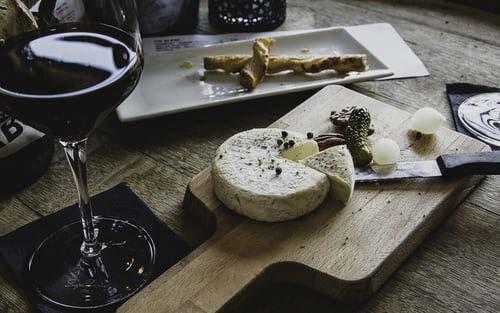
3 minute read
MATCHING CHEESE AND WINE
MATCHING CHEESE AND WINE
As we have seen so far, there are multiple kinds of wine and cheese, and there is a solid theory about their matching, aimed at exalting the mutual taste. The first general rule to consider when analyzing the accompaniment of wine and cheese is that a cheese with stronger taste requires a full-bodied wine. However, there can be made several differences. 8,9
Advertisement

According to seasoning
Fresh cheese has usually a more delicate taste. It is softer and its taste is lighter and sweeter, due to the higher presence of the taste of milk. Because of the clear scent of milk, the taste is also pleasantly acidic. In order to clean your mouth from the fat and pasty consistency and from the acidulous scent, you need to associate these kinds of cheese (such as Crescenza, Robiola e Squacquerone) with a white wine, dry and not sparkling. It should therefore be fruity and not sour.
Match with: Soave; Colli di Romagna Bianco; Bianco di Pitigliano; Lugana; Verdicchio; Pinot Bianco; Chardonnay.

Seasoned cheese
Seasoned cheese has a generally harder consistency and a strong, sapid aroma. This scent is persistent in the mouth after savouring the cheese, and the related wine should not fight this feeling but enhance it. Thus, the perfect wine with a mature cheese is a red, full-bodied wine, which does not clean your mouth, unlike fresh cheese, but co-habit in it, and increase the aroma melting in an overall well-rounded flavour.
Match with: Brunello/Rosso di Montalcino; Nobile di Montepulciano; Chianti Classico Riserva; Montepulciano d’Abruzzo; Barolo; Amarone; Cannonau; Malvasia di Bosa.

According to the crust
“A crosta fiorita” cheese (with flowery crust) goes through a process of insertion of bacteria, which guarantees a strong flavour, sapid (especially for parts close to the crust) slightly spicy and, in the central bits, leaning towards sweet. For this reason, they should be consumed with red wines that have a rounded flavour and are medium-bodied: this last thing is important to avoid the wine stealing the scene.
Match with: Sangiovese from Tuscany and Romagna; Chianti; Nobile di Montepulciano
“A crosta lavata” cheese (with washed crust) has its crust washed several times, so that specific and selected bacteria naturally grow on it, giving to the cheese an aromatic and sometimes spicy flavour. The taste is thus softer than the previous one, but it can be more aromatic. It should therefore be balanced with a fruity red wine with a slight tannic presence. Also sapid and fresh white wines could be a good fit, if the cheese is particularly fat and sweet, with a mechanism similar to the one seen for non-seasoned cheese.
Match with: Teroldego Rotaliano or Dolcetto from Pidmont; Colli Orientali del Friuli Picolit or Gewürztraminer Alto Adige.

A particular kind of cheese: “erborinato”
Erborinato cheese is a product in which cultures of mold are encouraged to grow. They are usually Penicillium and give to the cheese blue spots and a characteristic odour and flavour. This is a very strong and sapid taste, which is persistent in the mouth for a long time. It can also be extremely spicy and sharp. According to the sharpness of the cheese it is accompanied with different wines: if it is not heavily sharp it should be consumed with a red, round and alcoholic wine, which enhance the depth of the cheese. Otherwise, if the sharpness is extreme, a fortified and sweet wine should be preferred, in order to distinguish and highlight both flavours, instead of reciprocally cancelling the taste.
Match with: Barolo; Barbaresco; Amarone (less sharp cheese). Passito di Pantelleria; Cinque Terre Sciacchetrà; Vin Santo (not the sweet version for desserts); Moscato (sharper cheese).









